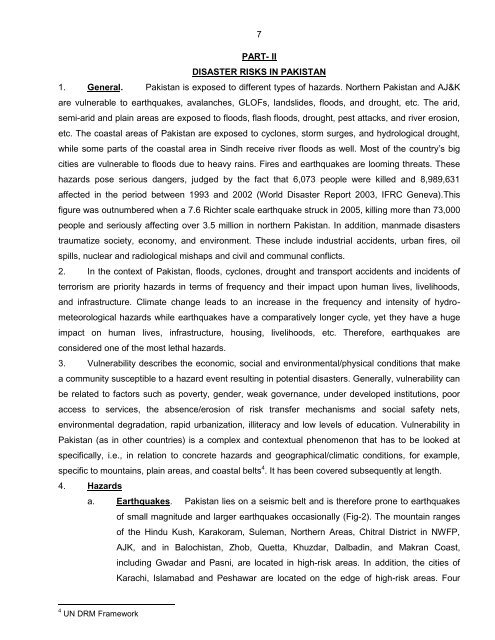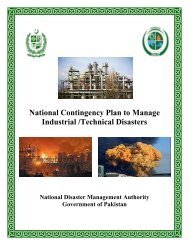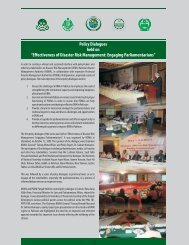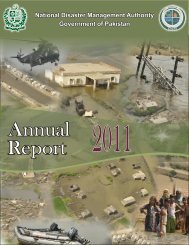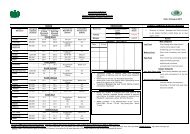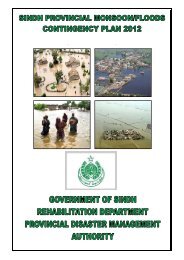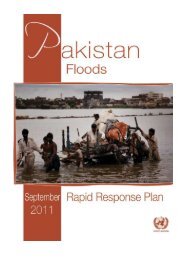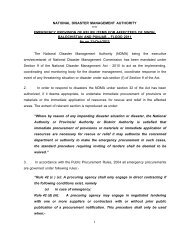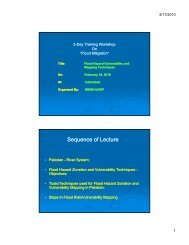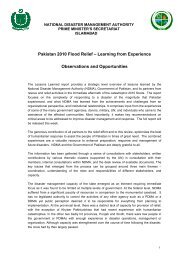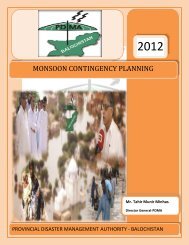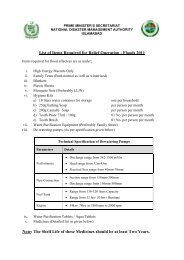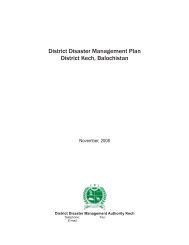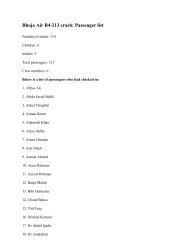National Disaster Response Plan (NDRP) March 2010 - NDMA
National Disaster Response Plan (NDRP) March 2010 - NDMA
National Disaster Response Plan (NDRP) March 2010 - NDMA
Create successful ePaper yourself
Turn your PDF publications into a flip-book with our unique Google optimized e-Paper software.
7<br />
PART- II<br />
DISASTER RISKS IN PAKISTAN<br />
1. General. Pakistan is exposed to different types of hazards. Northern Pakistan and AJ&K<br />
are vulnerable to earthquakes, avalanches, GLOFs, landslides, floods, and drought, etc. The arid,<br />
semi-arid and plain areas are exposed to floods, flash floods, drought, pest attacks, and river erosion,<br />
etc. The coastal areas of Pakistan are exposed to cyclones, storm surges, and hydrological drought,<br />
while some parts of the coastal area in Sindh receive river floods as well. Most of the country‟s big<br />
cities are vulnerable to floods due to heavy rains. Fires and earthquakes are looming threats. These<br />
hazards pose serious dangers, judged by the fact that 6,073 people were killed and 8,989,631<br />
affected in the period between 1993 and 2002 (World <strong>Disaster</strong> Report 2003, IFRC Geneva).This<br />
figure was outnumbered when a 7.6 Richter scale earthquake struck in 2005, killing more than 73,000<br />
people and seriously affecting over 3.5 million in northern Pakistan. In addition, manmade disasters<br />
traumatize society, economy, and environment. These include industrial accidents, urban fires, oil<br />
spills, nuclear and radiological mishaps and civil and communal conflicts.<br />
2. In the context of Pakistan, floods, cyclones, drought and transport accidents and incidents of<br />
terrorism are priority hazards in terms of frequency and their impact upon human lives, livelihoods,<br />
and infrastructure. Climate change leads to an increase in the frequency and intensity of hydro-<br />
meteorological hazards while earthquakes have a comparatively longer cycle, yet they have a huge<br />
impact on human lives, infrastructure, housing, livelihoods, etc. Therefore, earthquakes are<br />
considered one of the most lethal hazards.<br />
3. Vulnerability describes the economic, social and environmental/physical conditions that make<br />
a community susceptible to a hazard event resulting in potential disasters. Generally, vulnerability can<br />
be related to factors such as poverty, gender, weak governance, under developed institutions, poor<br />
access to services, the absence/erosion of risk transfer mechanisms and social safety nets,<br />
environmental degradation, rapid urbanization, illiteracy and low levels of education. Vulnerability in<br />
Pakistan (as in other countries) is a complex and contextual phenomenon that has to be looked at<br />
specifically, i.e., in relation to concrete hazards and geographical/climatic conditions, for example,<br />
specific to mountains, plain areas, and coastal belts 4 . It has been covered subsequently at length.<br />
4. Hazards<br />
a. Earthquakes. Pakistan lies on a seismic belt and is therefore prone to earthquakes<br />
4 UN DRM Framework<br />
of small magnitude and larger earthquakes occasionally (Fig-2). The mountain ranges<br />
of the Hindu Kush, Karakoram, Suleman, Northern Areas, Chitral District in NWFP,<br />
AJK, and in Balochistan, Zhob, Quetta, Khuzdar, Dalbadin, and Makran Coast,<br />
including Gwadar and Pasni, are located in high-risk areas. In addition, the cities of<br />
Karachi, Islamabad and Peshawar are located on the edge of high-risk areas. Four


